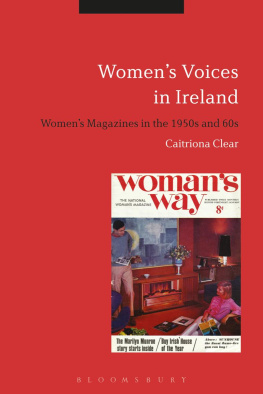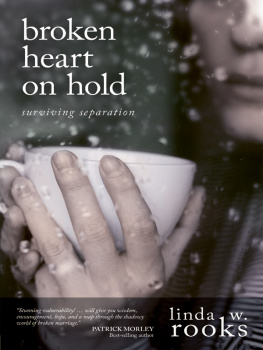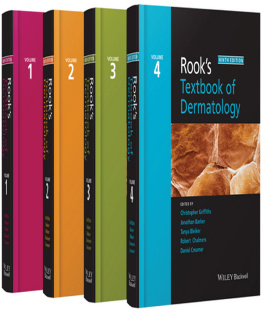Womens Magazines in Print and New Media
This book contributes to our collective understanding of the significance of representations of women and gender in magazines in both their print and online forms. The essays are authored by scholars, writers and cultural producers in fields such as art, film and visual studies, literature, critical race studies, communications, broadcast and print journalism, history, and womens and gender studies. Taken as a whole, the volume offers historical breadth and perspectives that are transnational and cross-racial on women in magazines and digital media in a variety of ways. It examines how women are represented, how women have created and produced magazines and how women make meaning of themselves and their world using magazines as key sources of information.
Noliwe Rooks is an Associate Professor in Africana Studies and Feminist, Gender, and Sexuality Studies at Cornell University.
Victoria Rose Pass is an Assistant Professor of Art History at Salisbury University in Maryland.
Ayana K. Weekley is an Assistant Professor in the Women, Gender, and Sexuality Studies Department at Grand Valley State University in Allendale, Michigan.
Routledge Research in Gender and Society
For a full list of titles in this series, please visit www.routledge.com
45 New Dynamics in Female Migration and Integration
Edited by Christiane Timmerman, Marco Martiniello, Andrea Rea and Johan Wets
46 Masculinities and Femininities in Latin Americas Uneven Development
Susan Paulson
47 Gender, Nutrition, and the Human Right to Adequate Food
Toward an Inclusive Framework
Edited by Anne C. Bellows, Flavio L.S. Valente, Stefanie Lemke, and Mara Daniela Nez Burbano de Lara
48 Teaching Womens Studies in Conservative Contexts
Considering Perspectives for an Inclusive Dialogue
Edited by Cantice Greene
49 Ageing, Gender and Sexuality
Equality in Later Life
Sue Westwood
50 Gendering the Memory of Work
Women Workers Narratives
Maria Tamboukou
51 Mens Intrusion, Womens Embodiment
A Critical Analysis of Street Harassment
Fiona Vera Gray
52 Neoliberal Bodies and the Gendered Fat Body
Hannele S. Harjunen
53 Womens Magazines in Print and New Media
Edited by Noliwe Rooks, Victoria Rose Pass and Ayana K. Weekley
First published 2017
by Routledge
711 Third Avenue, New York, NY 10017
and by Routledge
2 Park Square, Milton Park, Abingdon, Oxon OX14 4RN
Routledge is an imprint of the Taylor & Francis Group, an informa business
2017 Taylor & Francis
The right of the editors to be identified as the authors of the editorial material, and of the authors for their individual chapters, has been asserted in accordance with sections 77 and 78 of the Copyright, Designs and Patents Act 1988.
All rights reserved. No part of this book may be reprinted or reproduced or utilised in any form or by any electronic, mechanical, or other means, now known or hereafter invented, including photocopying and recording, or in any information storage or retrieval system, without permission in writing from the publishers.
Trademark notice: Product or corporate names may be trademarks or registered trademarks, and are used only for identification and explanation without intent to infringe.
Library of Congress Cataloging in Publication Data
CIP data has been applied for.
ISBN: 978-1-138-67984-9 (hbk)
ISBN: 978-1-315-54462-5 (ebk)
Typeset in Sabon
by ApexCoVantage, LLC
Noliwe Rooks
Comprised of thirteen essays first presented at the second international conference on Women and Magazines held at Cornell University in October of 2013, Womens Magazines in Print and New Media contributes to our collective understanding of the significance of representations of women and gender in magazines both old and new. The essays are authored by scholars, writers and cultural producers in fields such as art, film and visual studies, literature, critical race studies, communications, broadcast and print journalism, history, and women and gender studies. Taken as a whole, the volume offers historical breadth and perspectives that are both cross-national and cross-racial on women in magazines in a variety of ways. It examines how women are represented, how women have created and produced magazines and the various ways women make meaning of themselves and their world using magazines as key sources of information. Indeed, what this volume makes clear is that magazines are as diverse as are their readers and that they have served an astonishing array of audiences and purposes. As such, the contributors introduce a wide variety of periodicals on which their research is based including mass-market publications such as the Saturday Evening Post , to 1970s niche publications like Essence and Cosmopolitan . There are also essays exploring changes that have transformed entertainment and mass culture industries in the last few decades, such as the growth of reality television and the rise of digital publications. As a result, in addition to its many other contributions, this collection offers insights into how scholars from a range of academic disciplines use magazines to investigate wider questions about the changing nature of society and the roles of gender and race in shaping our understanding of it.
The history of popular, mass-marketed magazines aimed specifically at women dates back to the inaugural issue of Harpers Bazaar , which began publication a few years after the end of the American Civil War in 1867. Across continents, ethnicities and race, by the mid-twentieth century, millions of women read the various publications and columns that focused on the supposedly womanly concerns of housekeeping, child rearing, family, and appearance in order to garner clues as to how they could and should both behave in private or appear in public if they wanted societal acceptance. Magazines told women how they should groom and clean their homes, husbands, children and themselves if they wanted to be real, acceptable, or even ideal women. By the 1960s, with the rise of both the Black Power and womens movements, such content sparked a backlash and voices rose to roundly criticize magazines and even their willing readers as at best old-fashioned, and at worst exclusionary and deliberately set on controlling and damaging women through their embrace of gender norms and ideals. Despite such cultural clashes and tensions, this volume makes clear that the magazine industry was and remains diverse, as are womens experiences of it as readers, creators, and contributors. As a result, to study women and magazines is also to explore and complicate easy assertions and understandings of womens relationship to the magazines they read as well as the cultures within which they live.
Overall, magazines occupy a place of importance within both mass and popular culture and as such have long played a key role in the everyday lives of readers across class, race, and gender and are a fertile space for the expression of social and political philosophies. Indeed, the forms such publications have taken are staggeringly diversemass market publications, Xeroxed fanzines, cheap weeklies for the working class, glossy magazines for the so-called smart set, guides for the home economist, specialized trade publications, political mouthpieces and popular tabloids. As such, through image and text, they serve as a particularly rich and potent site for understanding cultural shifts and transformations, and are important outlets for defining what it means to be a part of a certain community, class, or even generation.








